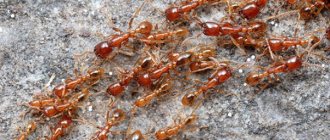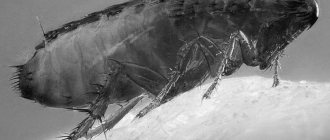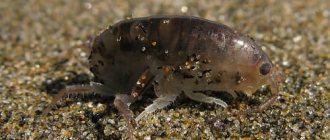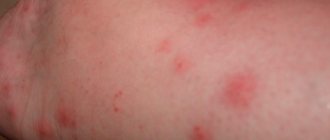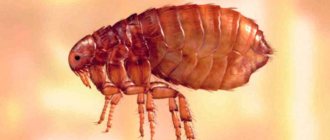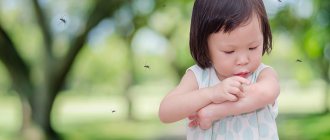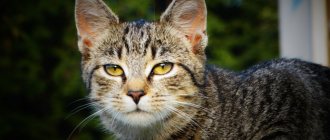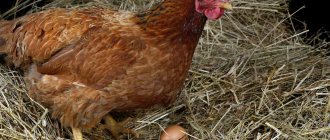Red ants, or fire ants as they are also called, got their name for their bright red color and extremely painful bites, after which the skin burns as if from a burn.
When settling in a house, little aggressors are able to literally evict a person from their home, creating an unbearable living environment. They eat food supplies, stain everything in the house with their secretions, spoil things, and at the same time bite very painfully.
It is very difficult to get rid of red ants, since they are practically immune to pesticides and multiply very quickly, filling the house in a fairly short period of time.
What they look like
The bodies of mature individuals are divided into three parts: head, thorax, abdominal cavity with three pairs of legs and a pair of antennae. Fire ants can be distinguished from others by their copper-brown head and body with a dark belly. Workers are blackish to reddish in color. The size varies from 2 to 6 mm. Ants of different sizes are present in the nest at the same time.
Solenopsis spp. identified by three body features: Leg with two nodes. Unarmed propodeum. Antennas with 10 segments plus a two-segment baton. Fire ants bite and spray formic acid. The bite causes irritation. They have a special venom in the stinger that injects the alkaloid, as well as jaws for stinging.
Traditional methods
Control methods used by the public before the invention of chemical insecticides were based on the use of pharmaceutical borax or boric acid (available over the counter).
To get rid of ants, baits that are placed along the path of insects are effective. Products with a strong attractive odor are mixed with brown, approximate proportion: for 1 glass of tinder, 1 tablespoon of the drug. It can be used:
- sugar or honey solution;
- ground meat;
- boiled potatoes.
The smell of ants is scary:
- vinegar;
- citrus;
- spices (turmeric, pepper, cloves).
Sprinkle or spray the surfaces on which pests move with an aqueous solution.
Behavior
A typical fire ant colony creates large mounds in open areas. Feeds on young plants and seeds. They attack small animals and can kill them. Unlike many other species that bite then spray acid into the wound, fire ants bite only to grab, then sting (from the abdomen).
The sting injects a toxic alkaloid venom called solenopsin, a compound from the piperidine class. For humans, it is a painful sting, feeling like a burn (hence the name). Subsequent exposure to the poison can be fatal for sensitive people.
Fire ants are more aggressive than most native species and have pushed others out of their native habitat. For example, they parasitize bees Euglossa imperialis, through orchid species. They enter the hive from below and loot the contents of the cells.
These ants are known for their ability to survive in extreme conditions. They do not hibernate, but can survive cold conditions.
With other insects
Red fire ants are known to form reciprocal relationships with several species of Lycaenidae and Riodinidae butterflies. In Lycaena rubidus, the larvae secrete a liquid with a high sugar content. The ants return the larvae back to the nest and protect the pupal stage in exchange for fluid feeding. For the larvae of Eurybia elvina, soil shelters are built on the inflorescences.
Fire ants nest in the soil near damp places such as river banks, ponds, lawns, and highways. Usually the anthill is not visible because it is built under wood, logs, stones, and bricks. If there is no shelter, domed mounds are built.
They can only be observed in open spaces, such as fields, parks, and lawns. These mounds reach a height of 40 cm, higher on heavy soils - 1.0 and 1.5 meters in diameter. Colonies are founded by small groups of queens or individuals.
Even if only one queen survives for a month or so, the colony consists of thousands of individuals. Some are polygynous (have several queens per nest).
Insects are resilient and can survive floods. During Hurricane Harvey in Texas in 2022, clusters of fire ants known as rafts were observed on the surface of the water. Each cluster had as many as 100,000 individual individuals that formed a temporary structure until they found a new permanent home.
Fire ants dig tunnels efficiently, using about 30% of the nest's population, thereby avoiding congestion in the tunnels.
Lifestyle of the most dangerous insects
Ants are considered insects that can cause a lot of surprise. We can start with the fact that these creatures, which do not have a developed brain, act quite clearly and organized when protecting their family and obtaining food. They also surprise with the structure of their community. The most dangerous insects, fire ants, live in an anthill they built on their own, and their reproduction takes place there. Reproductive individuals have the ability to reproduce by cloning, mating only to produce sterile workers. Throughout her life, the queen gives birth to numerous offspring (about a quarter of a million ants).
The diet of these ants consists of plant and animal foods; they do not distinguish between them and happily eat both types. Basically, insects with a passion eat sprouts of herbal plants and shoots of small shrubs. The diet includes different types of insects, larvae, and caterpillars. Fire goosebumps often attack even mice, frogs and snakes, and do not ignore the corpses of large animals. When attacking a victim, ants in a large group climb up the legs of the victim's body. They dig into the skin with their mouthparts and insert a sting. This is how a considerable dose of poison enters the animal’s body, which is toxic. At the site of the bite, the skin begins to burn severely, and unbearable pain occurs.
Roles
Queen
Fire ant queens, the reproductive females, are the largest. Their main function is reproduction. The queen seeks to establish a new colony after her mating flight. At the new location, she uses a special poison to paralyze intruders without workers to protect her.
They live up to seven years and produce up to 1,600 eggs per day. Their anthills support up to 250,000 workers. Young, virgin queens have wings (like males), but shed them after mating.
Males (drones)
The main purpose of males is to mate with queens during the nuptial flight. Once the male successfully impregnates the queen, his goal is completed. It is not accepted back into the mother colony and dies outside the nest.
Other roles
There are other types of roles that are performed by workers. Basic ants are known for their larger size and more powerful mandibular jaws, commonly used for maceration and food storage.
Find out more Steppe reaper ant - behavior, nutrition, keeping at home
Small ones perform ordinary tasks (caring for eggs, larvae, pupae, cleaning the nest, obtaining food). Solenopsis daguerrei do not have workers - they are considered social parasites.
Life cycle
Researchers have not yet fully studied the method of reproduction.
Cloning
This species has cloning. Females and males produce a genetic copy of themselves. As a result of mating, only working individuals are obtained that cannot have offspring.
Reproduction
Red ants have a hard time getting along with other species. But there were cases when they crossed with individuals from another variety, forming offspring.
Appearance of larvae
Each anthill has several queens. In this regard, labor is always present. After laying eggs, larvae hatch 7 days later. Usually their diameter does not exceed 0.5 mm. Larvae form within 2 weeks.
Lifespan
The lifespan of the uterus is about 3-4 years. During this period, it produces about 500,000 individuals. In warmer climates, ants live longer. Workers and males live from several days to 2 years.
How to eliminate the source of fire ants
Most fire ant species do not bother people and are not invasive. Solenopsis invicta, known as the red imported fire ant (RIFA), is an invasive pest in many areas of the world: USA, Australia, China, Taiwan.
RIFA were believed to have been accidentally introduced into countries through shipping crates. They were thought to be found in the Philippines, but are most likely confused with Solenopsis geminata.
The FDA estimates that 30–60% of people living in infested areas are bitten each year. RIFA are found primarily in the subtropical southeastern US states:
- Florida;
- Georgia;
- South Carolina;
- Louisiana;
- Mississippi;
- Alabama;
- parts of North Carolina;
- Virginia;
- Tennessee;
- Arkansas;
- Texas;
- Oklahoma;
- New Mexico;
- California.
Current national control or eradication programs are not particularly effective. The insects have adapted - they now have longer legs and new behaviors that help them avoid danger.
Habitats
In nature, red ants can be found near water, in places with a temperate climate. Urban insects occupy cavities in asphalt, traffic lights, and stationary trash cans. Penetrating into a living space, pests settle in any suitable places:
- spaces behind the baseboards
- kitchen cabinets
- old wallpaper
- computers and televisions
- ceiling beams
- large gaps in the floor and walls
The decisive factor for the rapid reproduction of red ants is warmth. In damp and warm houses, insects multiply with incredible speed.
Natural enemies
Phorid flies, Phoridae, are a large family of small, humpbacked flies, somewhat smaller than vinegar flies. Two species of this family (Pseudacteon tricuspis, Pseudacteon curvatus) are parasites of the red fire ant in South America.
About 110 species of Pseudacteon have been described. Pseudoactons reproduce by laying eggs on the ant's thorax. The first instar larvae migrate to the head, then develop, feeding on hemolymph, muscle, and nervous tissue.
After about two weeks, they cause the insect's head to drop by releasing an enzyme that dissolves the membrane that attaches the ant's head to the body. The fly pupates in the severed head capsule, which emerges after two weeks.
Pseudoacton flies are important ecological controls on Solenopsis. They are introduced throughout the southern United States.
Plants
The Venus flytrap, a carnivorous plant, is found only in North and South Carolina in the United States. About 33% of the Venus flytrap's prey are ants of various species. They lure prey with sweet juice.
Once the insect has entered the trap and touched two or three “trigger hairs,” bristles on the surface of the leaf cover the prey. They limit it behind the “teeth” around the perimeter and digest it. Other carnivorous plants, such as sundews (Drosera), also trap insects.
The main natural enemies of fire ants include other species of ants, which attack queens during the period of nest establishment, when there are no workers protecting the emerging colony.
A number of entomopathogenic fungi are natural enemies. For example, Beauveria bassiana, Metarhizium anisopliae. The latter is commercially available for biological control (i.e. without pesticides) of various insect pests. New technology has increased its service life and effectiveness against fire ants.
The ant is a little strong man. Description, species, lifestyle and habitat of the collective insect
On our huge planet there are many types of living organisms. The variety of animals and insects is simply amazing.
Among insects we know many examples. Mosquitoes, flies, bees and so on.
But there is another very interesting insect that we would like to talk about in this article.
So, in this article we will tell you about ants. Interested, read on.
Description of ants
In the photographs, the ants are depicted as very miniature and defenseless insects that do not represent anything. But this is a fundamentally incorrect statement.
Let's find out if this is true. We present to you a brief description of ants.
The body of a classic ant consists of three parts:
Ants' eyes have many different lenses. These lenses do not allow their owners to see clearly; they only coordinate the movement of ants.
Ants use their legs as their main means of locomotion. Ants have six of them. They have thin claws that provide better grip on the surface.
Smells, by the way, are not the last place in the life of ants.
Smell can give an ant a lot of information. For example, ants can distinguish a stranger from a member of their family using smell.
As a means of defense, ants have a special poison with which they injure their ill-wisher. This poison is produced in the ant's body using a special group of glands.
Dimensions. As you all know, the ant is one of the smallest animals that the human eye can see without external instruments.
On average, the size of this baby reaches 2-3 mm. In addition, depending on the type of ant, the size of the male and female may vary. In some species the female is much larger than the male, while in others they are the same size.
Female ants have small wings on their bodies, which the female immediately loses at the end of the mating season.
Existing species of ants
Of course, there are an incredible variety of ant species across the planet. We will tell you about the main and most common:
- Red ants.
- Giant ants.
Red fire ant
We are sure that you have all heard about the red ant, which is also called the fire ant. Indeed, this type of ant is very popular.
So, this type of ant is one of the most dangerous, due to its incredibly dangerous poison, which can be fatal even in humans if he has an individual allergy.
They live mainly in European countries and Russia. Average sizes from 3-7 mm.
They prefer to use the bodies of dead arthropod mammals as their food. This makes this type of ant more of a scavenger than a predator.
Giant ants
The name of these ants speaks for itself. This type of ant is the largest on the entire planet. It can reach up to 35 mm in length. This is an incredibly large figure, given the size of ordinary ants.
The main habitat is South America.
The most important feature of this species is that such ants do not have queens. Due to their size, females may well take over the function of the uterus.
Relationship between ants and people
Surely, if you have a summer house, then you have encountered such a problem as ants in the garden.
The vegetable garden or flowers suffer greatly from ants, because the ants simply eat various berries and herbs.
Summer residents have already put forward many ways to combat such garden parasites.
Conclusion
Ants are quite unusual and interesting insects; being quite small in size, ants can lift weights several hundred times heavier than their own weight.
We have provided you with a lot of useful information about ants. From this article you learned about the types of ants, their anatomical features, and even about country ants. We really hope you found it interesting. All the best!
Red imported fire ants
The red fire ant (Solenopsis invicta) is native to South America and has spread to Australia, New Zealand, Asia, and the Caribbean. United States of America (USA). The International Union for Conservation of Nature (IUCN) has named them one of the world's most invasive species.
Impact
Insects pose a serious problem because they cause significant environmental, social, and economic damage.
Ecological
Fire ants are very aggressive, voraciously feeding on land animals such as insects, frogs, reptiles, birds, and mammals. Native animals are displaced or destroyed.
They pose a threat to native plants because they eat and damage seeds and seedlings. These impacts cause severe disruptions to ecosystems over time.
Social
Fire ants pose a serious threat to human health due to their sting, which causes a painful burning sensation. They swarm to attack and sting repeatedly.
Bites can be fatal if a severe allergic reaction (anaphylaxis) occurs. There is a risk of secondary infection if the blisters or pustules resulting from the bites are broken.
Everyday activities such as barbecues, picnics, sports activities are not possible in areas with heavy infestation. Pets may also be bitten and injured, have allergic reactions, or go blind from exposure to the venom.
Economic
Insects kill farm animals and crops, with newborn animals particularly vulnerable. Fire ants pierce the eyes, mouth, and nose, causing blindness, swelling, and suffocation.
They penetrate the food and water supplies of animals and prevent them from eating, which leads to starvation and dehydration. They damage crops, eat seeds, and pass through roots and stems.
Find out more 10 crazy facts about ants
They protect certain types of harmful insects that produce powdery mildew. The increased presence of these pests affects the quality of products and contributes to the spread of diseases.
In the US, fire anthills have destroyed equipment such as irrigation systems and damaged machinery during harvesting operations.
Anthills are a problem on lawns, sports fields, and golf courses. Ants damage roads, paths, and expensive electrical equipment, often seriously.
Inhabitants of our country
If we talk about the territory of our country, then this species is quite rare, since such living conditions are not entirely suitable for them. Our territory is inhabited by red ants, which are popularly known as fire ants. Compared to fiery ones, they cannot be called aggressive, but on the contrary, compared to them they look very peaceful.
They live in natural conditions, preferring to set up anthills in coniferous and deciduous forests. They are very useful insects, since they are directly involved in the formation of a nutritious soil layer for plants; in addition, they are forest orderlies, since they destroy pests. They do not pose any danger to humans.
European look
Myrmica rubra, known as the European fire ant or common red ant, is from the genus Myrmica. Found throughout Europe, invasive in parts of North America and Asia. It is red in color, with dark pigmentation on the head.
Lives under stones, fallen trees, in the soil. Aggressive, often attacks rather than running away, can bite, although does not have the ability to spray formic acid like Formica.
It is found in the region from Portugal to Eastern Siberia (up to Transbaikalia), from northern Greece to the forest-tundra zone in the north. In Japan and North America, it is considered unpleasant and aggressive.
Anthills are polygynous, with up to one hundred queens per nest. Queens gather together after the nuptial flight, form a nest, and lay eggs.
The species is polydomous, with many nests per colony. Queens live up to fifteen years. Mating flights in Europe take place from late July to mid-August. Hundreds of young winged insects take to the air to mate.
After this, the males die and the queens shed their wings to create a new anthill. They do not fly in North America, but swarms of only males have been recorded in Newfoundland, Canada.
Very common in Europe, they live in meadows and gardens. They feed on powdery mildew secreted by aphids, insects, and invertebrates.
Fire ant venom is relatively well studied.
They will attack any creature that disturbs their nest, but are not as aggressive as the red imported fire ant. They also eat pollen, a phenomenon rarely seen in temperate zone ants.
Larvae of the butterflies Phengaris alcon (Alcon blue), P. teleius (rare large blue) use M. rubra as the main host.
Reproduction
Males and females of red ants mate in the same way as their relatives. This happens while flying over an anthill. Males die after mating. Well, the females lose their wings and lay eggs. At this time, their body does not need nutrition; it has enough nutrients with which it has filled itself. Over the course of her entire life, the queen is capable of reproducing up to 25,000 individuals of her own kind.
The eggs of red ants are very difficult to see with the naked eye. In the first days after emergence, the larvae need care, which is provided by nurse ants. Their main occupation is caring for their offspring; worker ants take care of their nutrition. Having gone through all the stages of its development, the larva turns into a pupa. But the care of the worker ants does not end there, because the pupa cannot even leave the cocoon without their help. The most hardworking creatures can cause quite a bit of trouble.
Fire ant poison
Toxic substances play an important role in the biology of fire ants, used for prey capture, protection, and antimicrobial action. Newborns contain virtually no of it, but one-day-old workers produce 1.17 mcg/day.
Upon reaching the age of 15 days, the amount decreases to 0.3 mcg. The poison is secreted and stored in the bag. When used, it is ejected through the main channel of the sting. The capacity is 20 - 40 nl, depending on the size of the insect.
American entomologist Justin O. Schmidt called it "sharp, sudden, slightly alarming." Gave a rating of "1" on the Schmidt Sting Pain Index, a scale that rates the intensity of pain from an insect sting from 0 to 4.
More than 95% of the components of the poison are water-insoluble alkaloids. Solenopsin has cytotoxic, hemolytic, necrotic, insecticidal, antibacterial, antifungal, and anti-HIV properties. Experiments show that the mean lethal dose (LD 50) for female rats is 0.36 mg/kg.
Approximately 46 proteins have been identified. They directly influence the anaphylactic reactions observed in people sensitive to the venom. Although these include neurotoxins and potential allergens, not all proteins are involved in venom function.
Squirrels benefit the colony. Some kill bacteria, which explains why workers spray poison around nests. Others bind pheromones, which help create chemical pathways for communication with conspecifics.
Store products
Modern industrial insecticides will help get rid of ants in a short time.
- The aerosol product “Raptor” is sprayed onto areas where insects accumulate.
- Long-acting gels such as “FAS” or “Raptor” are applied in dotted lines around the perimeter of the room.
- Plaster "Mashenka" is designed to treat an area of 25 square meters. The product is highly effective and very affordable.
- Raid traps are placed on ant trails, which can destroy the entire colony in a week.
- Delicia powder can be used in two ways: dissolve in water and spray behind baseboards, under furniture, etc., or spray where insects have been observed.
Symptoms and signs
Fire ant venom (>95%) consists of oily alkaloids derived from piperidine (solenopsin) mixed with small amounts of toxic proteins. Stinging ant bites are painful, characterized by a local burning sensation accompanied by hives. Turns into a bump, rash or blister within 20 minutes.
The bite site swells within a few hours. Causes further pain and irritation, especially after several bites in the same place.
The lump develops into a white pustule within 24–36 hours. It can become infected when scratched. Goes away spontaneously after a few days if left alone.
Pustules are intrusive and uncomfortable during activity. If they become infected, they can cause scarring. The formation of pustules occurs in almost every person bitten by ants.
Medicines such as antibiotics, diphenylhydrazines, epinephrines, and topical steroids do not affect pustular reactions.
Some people experience an allergy to the poison, including anaphylaxis, which requires emergency medical attention. Hypersensitivity occurs in those with certain medical problems, such as heart disease or diabetes.
Read more Amazing facts about the queen ant
The use of adrenaline is recommended. It has been proven that the formation of pustules occurs from the introduction of poison alkaloids; allergies to fire ant bites are caused exclusively by allergenic proteins.
In addition, neuropathy, seizures (without any evidence of previous systemic reactions), cerebrovascular injury, and nephrotic syndrome have been associated with fire ant venom.
Neurotoxins in the venom explain why some victims experience hallucinations after being stung.
First aid
First aid for a fire ant bite includes topical treatment and oral medications. There are many home remedies of varying effectiveness, including immediately applying a one-to-one solution of bleach and water or aloe vera gel.
External, local drugs - anesthetic benzocaine, antihistamine diphenhydramine, corticosteroid hydrocortisone.
Antihistamines or topical corticosteroids help reduce itching and local sting reactions. Tablets are antihistamines.
Severe allergic reactions to ant stings, including severe chest pain, nausea, heavy sweating, loss of breathing, severe swelling, slurred speech, are fatal if left untreated. Urgent medical attention is required.
Danger to animals
They are no less dangerous for animals; when attacked, the animal experiences severe pain. There is also a possibility of death. If a dog is bitten by such a creep, it will begin to develop pustular dermatosis, swelling and erythema will appear. Throughout the day, the animal suffers from symptoms.
They bite livestock in areas where there is the least amount of hair, so the belly area, ears and face are often affected. If goosebumps attack young livestock, most often this leads to blindness of the animals, in some cases to their death. These insects often attack weak individuals, who are less protected than strong and healthy ones. When treating animals, corticosteroids, antibiotics, and ointments are used.
There are known cases of attacks on rabbits, ferrets, squirrels, owl chicks, etc., all symptoms develop identically. These killer insects cause the death of livestock. When an animal is attacked, it licks the bitten areas in pain, which leads to them swallowing these bugs.
Once inside the animal, they remain alive for some period of time and continue to sting, which additionally causes damage to the gastrointestinal tract.
As you can see, the harm they cause is simply enormous, and in the United States enormous amounts of money, effort and time are spent on fighting them, but, unfortunately, it is not possible to get rid of such killers. Various control methods are used, helicopters are used to spray insecticide, people dig up anthills on their own using special equipment to completely destroy the nest, they pour boiling water over the colonies, but this does not bring results, people and animals continue to suffer, and food supplies are also destroyed.
After many years of struggle and the use of numerous methods, it has been proven that the most effective way to get rid of these terrible ants is the humpback fly.
She does not eat ants, but uses a very effective method of destroying individuals. This fly lays its offspring directly on living ants; they carry the eggs on themselves until the larva hatches, which kills the ant using a special enzyme. The enzyme eats away the ant's head, which allows the larva to feed and develop.
Treatment for fire ant bites
Epinephrine quickly reverses the adverse effects of dyspnea and hypotension.
It is suggested that a conservative approach be used when treating bite injuries. Treatment is based on symptoms. For minor injuries with symptoms including pustule formation and pain, over-the-counter products are available to prevent infection. Ants are removed by washing the area with antiseptic soap.
Victims with signs of anaphylaxis are treated with antihistamines, epinephrine, and parenteral corticosteroids. It is recommended that people who have suffered from anaphylaxis use an epinephrine auto-injector (EpiPen) if shortness of breath or hypotension occurs.
Immunotherapy (WBE) has been used to treat anaphylaxis since 1973. Anyone suspected of having an allergy is referred to an allergist for evaluation. The entire body of the ant is used for treatment, not just the poison.
Unlike ant venom immunotherapy (which is sometimes used), WBE contains proteins. To reduce sensitivity, dosage extracts are gradually introduced into the body. WBE is very effective in preventing systemic reactions. Not recommended for children with large local reactions; those who live in areas with severe infection are given an exception.
The recommended maintenance dose is 0.5 ml 1:100 w/v 1:10 w/v WBE. For venom immunotherapy, a common maintenance dose is 0.5 ml of a 1:200 (w/v) dilution.
During the build-up phase, it is recommended to dose weekly or biweekly. Patients receiving immunotherapy are required to receive treatment for three to five years and therapy for life, although there is no consensus on how long a person should be treated.
Damage caused
We can safely classify this species as a dangerous pest. Even a small colony can quickly make life unbearable. The most unpleasant moments of being next to red ants:
- quickly destroying food supplies;
- spread of dirt and infections throughout the house;
- Chipboard furniture, paper wallpaper, books and paintings also suffer from insects.
- when attacking a person, swelling and a rash may appear at the site of the bite, the person feels severe dizziness and nausea;
- If a large number of insects attack at the same time, anaphylactic shock and even death may occur.
Ant colonies often cause fires in apartments and private houses. Damaged insulation of electrical wiring of household appliances causes a short circuit, leading to fire.
Fighting fire ants: choosing the best means
If the threat to your health is not yet great, then in the fight against “fire ants” we recommend that you be patient and start with gels and traps. and only when this does not help, use powerful liquid products with fipronil and bifen.
Here are two of the best-selling and most popular products on Amazon.com: TERRO Ant Killer Liquid Ant Baits and Advion Ant Gel Insecticide with Plunger
TERRO Ant Killer Liquid Ant Baits
This is a plastic translucent trap with liquid filling inside for Indoor use, which costs ~$7. The manufacturer promises that TERRO destroys all domestic ants, including fire ants. The patented design of the device eliminates the possibility of the bait leaking out: pets and people cannot reach it.
How does the bait work? It is necessary to place several transparent plastic plates in places where ants accumulate or along “ant paths”. As a rule, insects move around the house along 1-2 specific routes: this is where they can be lured. The ants will climb into the trap, drink the bait and return to their home, where the poison they carry will poison dozens more ants. Moreover: with the help of the “pheramon” trail, the ant will tell its fellows about the sweet bait, which means they will also rush into the trap. And so on - until the possible complete reduction of the colony, because the transferred poison affects even the queen.
True, the developers recommend that buyers be patient. You will see the result not on the first day or even in the first week: this is a slow-acting weapon. It is the gradual poisoning of individuals that guarantees effective infection of the colony.
Please note that TERRO Ant Bait contains boric acid, so it must be handled with care.
How do customers respond to Terro?
People recognize TERRO as more effective than similar competing products. True, they blame him for the lack of a quick effect. Therefore, users advise not to remove the trap after the ants have disappeared from your home. As a rule, in such a situation, relapses are possible - the old “ant” paths will retain their effect. Another tip from users: you need to replace the liquid inside the trap more often if there are a LOT of ants. Some even talk about replacing it once a week, although the official description of the trap speaks of a period of three months. Apparently, it all depends on the number of insects in your house.
Advion Ant Gel Insecticide with Plunger
This is an expensive thing - ~$27 per set. We have before us an attractant gel that will turn any space covered with it into a trap. It is sweet, aromatic and actively attracts ants. The principle of operation of Advion is reminiscent of the work of traps with boric acid: the ant brings poison to the colony, where all its brothers, including the queen, die from it. But in this case, much more powerful chemicals are used. And the attractant introduced here is very strong - insects are attracted to it like a magnet.
Experienced users recommend making traps for this gel from foil or other substances that retain moisture. However, even if it disappears, you can easily update the contents of the trap: the gel should be applied in thin strips. As an option, you can pour the gel directly into the cracks where insects live. Or make dough/bread balls and then cover them with gel.
Of course, it is better to place these baits on ant trails or near the entrance to the ant nest. And after that, be patient and wait for the infected ants to begin their work. The main thing is not to stop them from “eating and getting infected.”
We found almost no complaints about this bait. Users' questions were raised only by the level of toxicity of the product (it is slightly higher than that of other products). This is the price of high efficiency and comfort!
